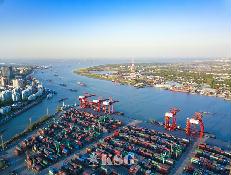2020-12-01 09:45
The Port of Hamburg – Throughput Shows Signs of Turnaround

At a rate of eight percent, the decline in seaborne cargo in Germany’s largest universal port lessened considerably in the third quarter compared to the second. The Port of Hamburg had shown a 16.2 percent loss in that quarter.
The negative effects of the worldwide coronavirus pandemic are still affecting developments in the Port of Hamburg’s cargo throughput. However, according to Port of Hamburg Marketing’s (HHM) assessment, the results in the third quarter give reason to be optimistic that the double-digit decrease in turnover has ended. It resulted in particular from a downswing in numerous economic sectors and lower demand for consumer goods. In HHM’s opinion, the third quarter showed signs of a beginning recovery.
“We have seen a stabilization in the development of throughput since July and with it a lower overall decrease in seaborne cargo handling in the Port of Hamburg. The reasons can be found in the lower rate of infections during the summer and the resulting easing of measures to check the pandemic, along with shipping to fill up stockpiles for the Christmas trade,” Axel Mattern, joint CEO of Port of Hamburg Marketing, explained. He emphasized that the Port of Hamburg continues to provide its cargo handling and logistics services 24/7. “Reliable supply of goods and raw materials for consumers and industry is ensured even under these difficult economic conditions,” he stressed, adding: “The port with its terminals and logistics and service providers as well as its transport connections to the hinterland is fully functional.”
In the first three quarters of the year, 93.2 million metric tons of seaborne cargo were loaded or discharged in the Port of Hamburg’s terminals. That marks a drop of 10.7 percent compared to the previous year. Both major segments of cargo throughput were affected and remained significantly below the levels reached a year earlier.
General cargo declined 9.9 percent to 65.2 million tons and bulk cargo was down 12.4 percent to 28 million tons. In container throughput, 6.3 million TEU (20-foot standard container units) were handled on Hamburg’s quays in the first three quarters. That represents an annualized decrease of 9.9 percent.
Developments in container traffic in the first three quarters varied among the Port of Hamburg’s ten most important trade partners. Positive developments in trade with other countries could not make up for the 11.3 percent drop in seaborne container shipping with China, which is Hamburg’s most important trade partner by far. Furthermore, Hamburg’s seaborne container throughput for other countries besides China also showed up to double-digit decreases: Russia (-15.1 percent), Sweden (-11.8 percent), South Korea (-11.8 percent), Denmark (-3.4 percent), and Poland (-9.6 percent).
Countries among the Port of Hamburg’s top ten trade partners that showed growth in container traffic were Singapore (up 7.1 percent), the UK (up 41.0 percent), and Malaysia (up 5.5 percent), along with the USA (up 0.1 percent). The USA ranks second for container throughput in Hamburg and still showed growth in the first three quarters of the year with a total of 439,000 TEU.
“The ongoing positive development in container traffic for the USA is surprising in light of the economy, which is suffering from the effects of the pandemic and the decline in demand. The growth in container shipping for Great Britain is based on an upswing in inbound empty containers for the German market and increased shipments to Great Britain in advance of the impending Brexit,” Ingo Egloff, joint CEO with Alex Mattern, explained.
< Korea Shipping Gazette >
많이 본 기사
- HMM, 7년만에 대서양항로 재진출…印-북유럽도 신설美서안 2주새 27% 급등…컨운임지수 4주 연속↑페스코, 우리나라·중국-극동러시아 컨항로 새단장안광헌 HD한국조선해양 사장, “초연결시대 조선공학과 해상법은 절친...광양항, 내년부터 ‘MSC·제미니’ 신규취항…유럽·미주·중동 항로...대만 양밍해운, 내달 中-태국 신항로 개설“온도관리기능 개선” EAS플랫폼, 유럽형 모듈 냉동탑차 출시왈레니우스윌헬름센, 3분기 영업익 4800억…2%↓KSS해운, 日 미쓰이와 130억 규모 암모니아운송 계약목포해양大, 예선조합과 항만안전 강화 제휴
- 울산항만공사, 내년 예산 2156억 확정…전년比 3%↑인천내항 1·8부두 재개발사업 본격화…실시협약 체결싱 EPS, 신조 중형 정유운반선에 공기흡입식 돛 설치“100억 감면효과” 연안여객선 세제혜택 제도 도입韓-베트남 AEO 상호인정약정…우리기업 신속통관 기대삼성중공업, 아시아서 7400억 규모 에탄운반선 3척 수주HJ중공업, 해군서 2663억 규모 신형고속정 4척 수주KSS해운, 사랑의 행복나눔 기부금·후원품 전달한국근해수송협의회 김근홍 국장 부친상부산항만공사, 내년 예산 22% 늘린 1조7338억 투입
스케줄 많이 검색한 항구

































































0/250
확인